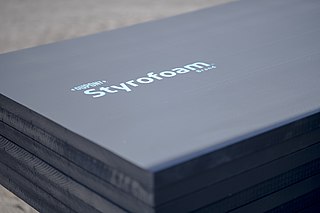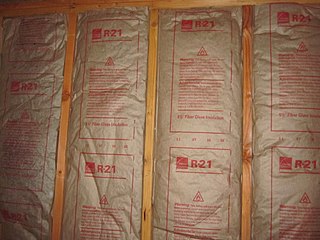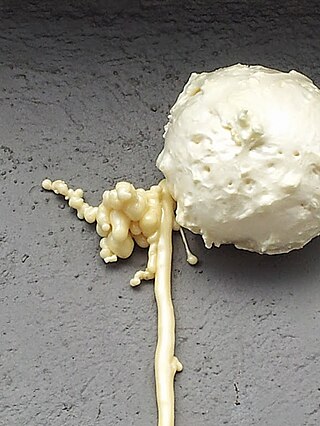Related Research Articles

Styrofoam is a trademarked brand of closed-cell extruded polystyrene foam (XPS), manufactured to provide continuous building insulation board used in walls, roofs, and foundations as thermal insulation and as a water barrier. This material is light blue in color and is owned and manufactured by DuPont. DuPont also has produced a line of green and white foam shapes for use in crafts and floral arrangements.

In the context of construction, the R-value is a measure of how well a two-dimensional barrier, such as a layer of insulation, a window or a complete wall or ceiling, resists the conductive flow of heat. R-value is the temperature difference per unit of heat flux needed to sustain one unit of heat flux between the warmer surface and colder surface of a barrier under steady-state conditions. The measure is therefore equally relevant for lowering energy bills for heating in the winter, for cooling in the summer, and for general comfort.

Straw-bale construction is a building method that uses bales of straw as structural elements, building insulation, or both. This construction method is commonly used in natural building or "brown" construction projects. Research has shown that straw-bale construction is a sustainable method for building, from the standpoint of both materials and energy needed for heating and cooling.

A structural insulated panel, or structural insulating panel, (SIP), is a form of sandwich panel used in the construction industry.

A radiant barrier is a type of building material that reflects thermal radiation and reduces heat transfer. Because thermal energy is also transferred by conduction and convection, in addition to radiation, radiant barriers are often supplemented with thermal insulation that slows down heat transfer by conduction or convection.

Green building refers to both a structure and the application of processes that are environmentally responsible and resource-efficient throughout a building's life-cycle: from planning to design, construction, operation, maintenance, renovation, and demolition. This requires close cooperation of the contractor, the architects, the engineers, and the client at all project stages. The Green Building practice expands and complements the classical building design concerns of economy, utility, durability, and comfort. Green building also refers to saving resources to the maximum extent, including energy saving, land saving, water saving, material saving, etc., during the whole life cycle of the building, protecting the environment and reducing pollution, providing people with healthy, comfortable and efficient use of space, and being in harmony with nature. Buildings that live in harmony; green building technology focuses on low consumption, high efficiency, economy, environmental protection, integration and optimization.’
In physics, energy density or volumic energy is the amount of energy stored in a given system or region of space per unit volume. It is sometimes confused with energy per unit mass which is properly called massic energy or gravimetric energy density.
A vacuum insulated panel (VIP) is a form of thermal insulation consisting of a gas-tight enclosure surrounding a rigid core, from which the air has been evacuated. It is used in building construction, refrigeration units, and insulated shipping containers to provide better insulation performance than conventional insulation materials.
Low emissivity refers to a surface condition that emits low levels of radiant thermal (heat) energy. All materials absorb, reflect, and emit radiant energy according to Planck's law but here, the primary concern is a special wavelength interval of radiant energy, namely thermal radiation of materials. In common use, especially building applications, the temperature range of approximately -40 to +80 degrees Celsius is the focus, but in aerospace and industrial process engineering, much broader ranges are of practical concern.

Polyisocyanurate, also referred to as PIR, polyiso, or ISO, is a thermoset plastic typically produced as a foam and used as rigid thermal insulation. The starting materials are similar to those used in polyurethane (PUR) except that the proportion of methylene diphenyl diisocyanate (MDI) is higher and a polyester-derived polyol is used in the reaction instead of a polyether polyol. The resulting chemical structure is significantly different, with the isocyanate groups on the MDI trimerising to form isocyanurate groups which the polyols link together, giving a complex polymeric structure.

Reflective surfaces, or ground-based albedo modification (GBAM), is a solar radiation management method of enhancing Earth's albedo. The IPCC described this method as "whitening roofs, changes in land use management, change of albedo at a larger scale ."
Domestic housing in the United Kingdom presents a possible opportunity for achieving the 20% overall cut in UK greenhouse gas emissions targeted by the Government for 2010. However, the process of achieving that drop is proving problematic given the very wide range of age and condition of the UK housing stock.

Building insulation is material used in a building to reduce the flow of thermal energy. While the majority of insulation in buildings is for thermal purposes, the term also applies to acoustic insulation, fire insulation, and impact insulation. Often an insulation material will be chosen for its ability to perform several of these functions at once.
Insulative paints, or insulating paints, are a specially designed type of paint in which can be used to coat a surface to reduce heat transfer as well as increase the thermal insulating property (R-value in order to aid cooling and heating efforts for example.Insulative paints use a technology where a broad spectrum thermally reflective coating is applied to a specific type of micro-spheres to block heat radiation in a larger range of thermal energy to dissipate heat rapidly. This type of coated thermally reflective material reduces heat transfer through the coating with 90% of solar infrared radiation and 85% of ultraviolet radiation being radiated back from the coated surface[1]

Building insulation materials are the building materials that form the thermal envelope of a building or otherwise reduce heat transfer.

Cellulose insulation is plant fiber used in wall and roof cavities to insulate, draught proof and reduce noise. Building insulation in general is low-thermal-conductivity material used to reduce building heat loss and gain and reduce noise transmission.

Spray foam is a chemical product created by two materials, isocyanate and polyol resin, which react when mixed with each other and expand up to 30-60 times its liquid volume after it is sprayed in place. This expansion makes it useful as a specialty packing material which forms to the shape of the product being packaged and produces a high thermal insulating value with virtually no air infiltration.
Window insulation reduces heat transfer from one side of a window to the other. The U-value is used to refer to the amount of heat that can pass through a window, called thermal transmittance, with a lower score being better. The U-factor of a window can often be found on the rating label of the window.

Insulating glass (IG) consists of two or more glass window panes separated by a space to reduce heat transfer across a part of the building envelope. A window with insulating glass is commonly known as double glazing or a double-paned window, triple glazing or a triple-paned window, or quadruple glazing or a quadruple-paned window, depending upon how many panes of glass are used in its construction.
References
- ↑ "Panasonic U-Vacua Vacuum Insulation Panels". b2b-api.panasonic.eu. Archived from the original on 15 February 2020.
- ↑ "Spaceloft Insulation Data Sheet" (PDF). starch.dk. Archived from the original (PDF) on October 18, 2012.
- 1 2 3 4 5 6 Energy Saving Trust. "CE71 – Insulation materials chart – thermal properties and environmental ratings". Energysavingtrust.org.uk. Retrieved 2014-02-23.
- ↑ "Archived copy" (PDF). Archived from the original (PDF) on 2014-10-21. Retrieved 2014-10-14.
{{cite web}}: CS1 maint: archived copy as title (link) - ↑ "R-Value Table, Insulation Values For Selected Materials". coloradoenergy.org.
- 1 2 3 4 Ristinen, Robert A., and Jack J. Kraushaar. Energy and the Environment. 2nd ed. Hoboken, NJ: John Wiley & Sons, Inc., 2006.
- 1 2 "The Icynene Insulation System". June 12, 2008. Archived from the original on June 12, 2008. Retrieved August 9, 2009.
- ↑ "Rice hulls in construction – Appropedia: The sustainability wiki". Appropedia. 2013-02-23. Retrieved 2014-02-23.
- ↑ "Products | Johns Manville Insulation". Jminsulation.com.au. Archived from the original on 2014-02-26. Retrieved 2014-02-23.
- ↑ "Green Building Materials, Green Products". Greendepot.com. Retrieved 24 February 2019.
- ↑ "What is Green Living?". Archived from the original on September 29, 2008. Retrieved May 8, 2009.
- ↑ "sheep's wool specifications" (PDF).
- ↑ "Portfolio of Spray Foam Insulation Products | Icynene". Archived from the original on 2014-07-23. Retrieved 2014-07-17.
- 1 2 "ICC Legacy Report ER-2833 – Cocoon Thermal and Sound Insulation Products". ICC Evaluation Services, Inc. Retrieved 2014-02-23.
- 1 2 "Buildings Energy Data Book". Buildingsdatabook.eren.doe.gov. Archived from the original on 2014-02-27. Retrieved 2014-02-23.
- 1 2 3 4 5 Brian Anderson (2006). "Conventions for U-value calculations" (PDF). Bre.co.uk. Retrieved 2014-02-23.
- ↑ "Evergreen Insulation - Types of insulation and R-Values". 27 July 2013. Retrieved 27 August 2021.
- ↑ "R-Value of Straw Bales Lower Than Previously Reported – EBN: 7:9" . Buildinggreen.com. September 1, 1998. Retrieved 2018-10-03.
- ↑ "Papercrete Thermal Test Report (includes R-Value)" (PDF). masongreenstar.com. Archived from the original (PDF) on 2014-07-07. Retrieved 2014-07-21.
- 1 2 "Home Design & Remodeling | Department of Energy". Energysavers.gov. Retrieved 2014-02-23.